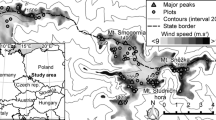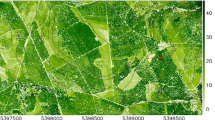Summary
The Department of Meteorology of Freiburg University is managing a microclimatological experimental site in a Scotch pine forest (Pinus silvestris L.) near Hartheim/Rhine in southern Germany. Measurements have been taken since the early seventies. The investigations at this measuring station also encompass recordings of wind direction and wind speed. The mean hourly wind speed values, measured in five heights above the trees, have now been recorded for ten consecutive years. An analysis of these records follows.
We calculated the hours of neutral atmospheric stratification by means of the local Richardson number. During these hours friction velocityu *, zero-plane displacementd and roughness lengthz 0 in the adiabatic surface layer of the atmosphere were determined. This enabled us to correlate the three parameters of the wind profile with the development of the geometry of the stand. The conclusion of the paper consists of further statistical statements about the wind speed above the growing forest.
Zusammenfassung
Das Meteorologische Institut der Universität Freiburg betreibt eine mikroklimatologische Meßstation in einem Kiefernwald (Pinus silvestris L.) bei Hartheim/Rhein in Südwestdeutschland. Die Messungen wurden Anfang der siebziger Jahre begonnen. Gemessen werden neben anderen Größen zur Bestimmung des Wärme- und Wasserhaushaltes auch Windrichtung und Windgeschwindigkeiten. Es liegen nun zehn Jahre ununterbrochene Meßreihen der Windgeschwindigkeit in fünf Niveaus auf Stundenbasis vor. Dieses Datenmaterial wird hier untersucht.
Die Stunden in denen die Atmosphäre neutral geschichtet war, wurden mit Hilfe der local Richardson number bestimmt. In diesen Zeiträumen konnte die Schubspannungsgeschwindigkeitu *, die Nullpunktverschiebung d und die Rauhigkeitslängez 0 errechnet werden. Anschließend werden die drei Windprofilparameter mit den Bestandshöhen in Beziehung gesetzt. Abschließend werden weitere statistische Untersuchungen zur Windgeschwindigkeit über diesem noch wachsenden Kiefernwald mitgeteilt.
Similar content being viewed by others
References
Deacon, E. L.: Vertical Diffusion in the Lowest Layers of the Atmosphere. Quart. J. R. Met. Soc.75, 89–103 (1949).
Jaeger, L., Kessler, A.: Langzeitmessungen der Strahlungsbilanz und ihrer Komponenten über einem Kiefernbestand der südlichen Oberrheinebene. All. Forst- u. Jagdzeitg.151, 210–218 (1980).
Jaeger, L.: Process Computers in Microclimatology. Siemens Power Engineering2, 72–74 (1980).
Jaeger, L.: Die klimatologische Meßstation Hartheim des Meteorologischen Instituts der Universität Freiburg i.Br. Ber. d. naturforschenden Ges. zu Freiburg i.Br.68, 47–76 (1978).
Jaeger, L.: Radiation Measurements of the Department of Meteorology of Freiburg University During the Experimental Stage of MESOKLIP. Met. Rdsch.34, 97–105 (1981).
Jarvis, P. G., James, G. B., Landsberg, J. J.: Coniferous Forest. In: Vegetation and the Atmosphere, Vol. 2 (Monteith, J. L., ed.), 439 pp. London-New York-San Francisco: Academic Press 1976.
Lettau, H. H.: Computation of Richardson Numbers, Classification of Wind Profiles, and Determination of Roughness Parameters. In: Exploring the Atmosphere’s First Mile, Vol. 2 (Lettau, H., Davidson, B., eds.). New York: Pergamon Press 1958.
Molin, L. C. B., Moore, C. J.: Estimating the Zero-Plane Displacement for Tall Vegetation Using a Mass Conservation Method. Boundary-Layer Met.26, 115–125 (1983).
Monteith, J. L.: Principles of Environmental Physics, 241 pp. London: Edward Arnold Publishers 1973.
Priestley, C. H. B.: Turbulent Transfer in the Lower Atmosphere, 130 pp. Chicago and London: The University of Chicago Press 1959.
Robinson, S. M.: A Method for Machine Computation of Wind Profile Parameters. In: Studies of the Three-Dimensional Structure of the Planetary Boundary-Layer (Lettau, H. H., ed.), pp. 63–70. Univ. of Wisconsin, Dept. of Meteorology, Annual report, Madison, 1961.
Schott, R.: Untersuchungen über die Energiehaushaltskomponenten in der atmosphärischen Grenzschicht am Beispiel eines Kiefernbestandes in der Oberrheinebene (Hartheim/Rh.). Ber. Dtsch. Wetteid. Nr. 153, Offenbach, 1980.
Stanhill, G.: A Simple Instrument for the Field Measurement of Turbulent Diffusion Flux. J. Appl. Met.8, 509–513 (1969).
Tajehman, S. J.: On Vertical Profiles of Meteorological Parameters Above a Layer of Rough Vegetation. J. Geophys. Res.78, 6381–6385 (1973).
Author information
Authors and Affiliations
Additional information
With 10 Figures
Rights and permissions
About this article
Cite this article
Jaeger, L. Climatology of wind profile parameter estimates above a growing pine forest. Arch. Met. Geoph. Biocl., Ser. B 34, 163–179 (1984). https://doi.org/10.1007/BF02275682
Received:
Issue Date:
DOI: https://doi.org/10.1007/BF02275682




